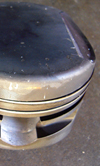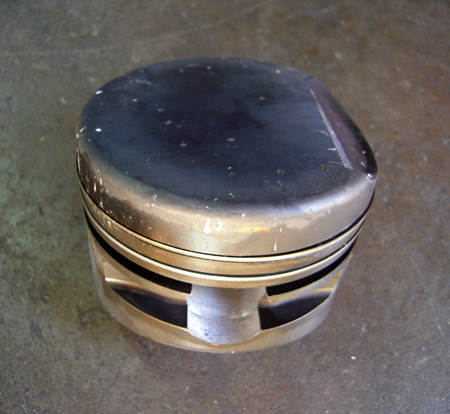Keeping pistons alive on a small Funny Car budget
 Jim Dunn is a throwback in the modern world of NHRA Full Throttle Drag Racing. Operating his professional Funny Car team on a budget that would embarrass amateurs, and doing so without computers, Dunn manages to procure sponsorship from good firms like dog food manufacturer Canidae and keep driver Paul Lee qualified in large Flopper fields.
Jim Dunn is a throwback in the modern world of NHRA Full Throttle Drag Racing. Operating his professional Funny Car team on a budget that would embarrass amateurs, and doing so without computers, Dunn manages to procure sponsorship from good firms like dog food manufacturer Canidae and keep driver Paul Lee qualified in large Flopper fields.
Dunn has been using Bill Miller Engineering (BME) pistons and con rods for at least 15 years, he says. "Well, I tried them all and I believe his are the best. Ninety percent of the people run his rods and I think some of them run other pistons because they sell them cheaper. I don't do that."
Dunn adds that he needs the strongest pistons he can get because they take all the beating on a 1000-ft catapult down the drag strip. Bill Miller says Dunn specifies a flat top made of 2618 aluminium with a special, proprietary hard coating applied.
Dunn specifies the compression he wants and whether he wants flat or domed tops for his pistons. "I run flat tops because they're less expensive and I really can't see any difference. Most guys run between 6:1 to 7:1 compression; I run 6.9:1 and the flat tops work fine for me," he told me.
According to Dunn, the magic of getting a piston to live is simple. "It all comes down to tuning," he says. "If the engine's happy (with his tune-up) and I ran a 4:08 at 308 [mph], I hurt one piston. Where it hurts pistons is when we drop a cylinder, because when the engine drops a cylinder it gives you an instant two or three more pounds of blower boost, but you still have the fuel going in. All of a sudden, the other seven pistons feel they need to catch it up and they just kill themselves."
Dunn believes it's impossible to stop piston breakage. "That's the game. We have to see how close we can get to blowing them up [the engines]," he says. He finds the most wear on the ring grooves. "If it's unhappy it'll be 'black death', which is like a two-cycle when it seizes - they're seizing but the other pistons have so much power it won't stop the engine enough. We'll beat them so hard we pull the wrist pin right out of the piston," Dunn states.
Dunn used about 200 pistons in 2010's 23-race season. He makes some races; at others he doesn't qualify for Sunday's eliminations. His car seems to run better as the season progresses and that is due to his budgetary concerns. He figures if he makes it through the first round, he can spend that much more money on the second, then the one after that and so on. "Instead of hurting one or two pistons, I'll hurt three or four (in a round). We'll spend that extra $1000 per run to go on," he says.

When NHRA first mandated 1000-foot racing, "Everyone said it was good not to have any oil-downs. I said, 'Give them three weeks and they'll all have 1000-ft fuses (referring to the engines).' Three weeks later, [John] Force had the white smoke coming out, just like he did at 1320."
After a plethora of late-season blow-ups, NHRA is returning to monetary penalties for oil-downs in 2011, forcing teams to be more diligent with their piston choices and their tune-ups. "All that does is hurt the little guys like me," Dunn says of the minimum $5000 fines.
"Everything is about the tune-up because you have to run it so close, and that's where the money comes in. I can't run it that close to breaking on the budget I have," Dunn explains. Sticking to his preferred tune-up, he runs the same design, same compression he's used since 1991. The dome has changed a little bit since then, but the compression height remains the same.
"Anything will work if you make it happy, so you have to have the right blower boost and the right fuel flow going into it. Low compression works and high compression works. It's just about getting the tune-up right - and luck!"
Fig. 1 - Jim Dunn's Bill Miller Engineering piston shows pitting but little other wear (Photo: Anne Proffit)
Written by Anne Proffit